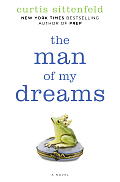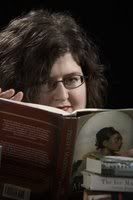 “Are there situations, long-term situations, where conflict does not wait around every bend, where time does not unspool only in anticipation of your errors” – from The Man of My Dreams
“Are there situations, long-term situations, where conflict does not wait around every bend, where time does not unspool only in anticipation of your errors” – from The Man of My DreamsHannah Gavener is fourteen in the summer of 1991, the summer she is sent away to her Aunt Elizabeth, the summer her mother finally leaves her father. Hannah’s childhood is spent trying not to provoke her father’s fury and in 1991, after he throws his wife and his daughters out of the house, Hannah’s mother decides she’s finally had enough.
However, even though Hannah doesn’t live with her father any longer, she hasn’t escaped his control. Hannah isn’t sure people really live happily, if it’s peaceful and they’re kind to each other, how does their life have any direction? Hannah’s life has always been directed by her father and preventing an escalation of conflict. “Every fight is about not just itself but all your massive personal inadequacies, your fundamental disrespect from him.” Now, as she enters her senior year of college, Hannah has done the unexpected and cut her father out of her life. Without her rudder, how will Hannah plot the course for the rest of her life? At what point does she have to stop blaming her problems on her messed-up childhood?
Curtis Sittenfeld’s first novel Prep was a breakout hit, ending up on many critics “best of 2005” lists. The Man of My Dreams is a novel that focuses inward and, as such, is unlikely to be as popular as Prep. Sittenfeld’s choice to move in a new direction was a wise one. Comparisons to Prep will happen; however, the two works bear little resemblance to each other except for Sittenfeld’s deft writing ability.
The Man of My Dreams, while beautifully written, is not a happy novel. Hannah lives in as unobtrusive manner as possible, avoiding anything that may “stir the pot,” as she has since childhood. Her father was “the weather system they all live with, and all of their behavior, whenever he is around, hinges on his mood.” Aversion therapy quickly trained Hannah and her sister Allison into approved behavior. “Your goal is not to instigate, and if you are successful, avoidance is its own reward.”
The sisters deal with the abuse of their childhood in very different ways. Allison, an outgoing and charismatic young woman, invites male attention and marries at twenty-four, although Hannah isn’t convinced that Allison truly loves Sam. Hannah heads to the other extreme by isolating herself and, when she finally does begin to interact with men, chooses those she can never truly “have,” preferring to be denied rather than having to open herself up to being hurt.
Hannah has difficulty believing that relationships exist where one doesn’t have to walk on eggshells. Her assumptions on male and female roles were formed from her early observations: men are strong and confident; women are “a little wimpy.” These stereotypes are born out later in her experiences in college where she observes the guys picking girls who need to be rescued. And so Hannah floats through relationships, taking whatever is offered to her but investing little of her self.
What isn’t clear is whether Hannah idolizes people who cause trouble or dislikes them. She tends toward passivity, but almost worships her cousin Fig’s flaunting of rules.
Hannah’s journey toward maturity is heartbreaking and what resonates with readers is the need to leave the past behind as new relationships are forged. How Sittenfeld shapes Hannah’s awakening will linger in reader’s minds long after the last page is read.
ISBN10: 1400064767
Publisher: Random House
Publication Date: May 16, 2006
Binding: Hardcover
Author Website: www.curtissittenfeld.com
tags: books book reviews fiction Curtis Sittenfeld family relationships


3 comments:
I shouldn't visit your blog... b/c I'm so tempted to read things I shouldn't be reading (like the above review)... LOL
Luckily I have been very good ;)
another aside:
I wasn't crazy about _Prep_...
I'm hoping I like this one more.
I haven't read Prep but from all the reviews I read of it, this is a very different style.
I'll be interested to hear what you think once you read this.
Post a Comment